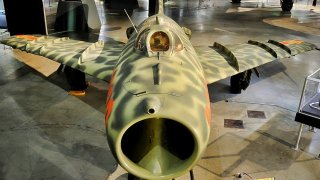MiG-17: The Cold War Fighter the U.S. Air Force Hated
The Soviet-era MiG-17 fighter platform is perhaps best recognized for its role in the Vietnam War. In 1965, North Vietnamese pilots quietly approached a pair of American F-8E Crusader fighter bombers above the Than Hoa Bridge.
The Soviet-era MiG-17 fighter platform is perhaps best recognized for its role in the Vietnam War. In 1965, North Vietnamese pilots quietly approached a pair of American F-8E Crusader fighter bombers above the Than Hoa Bridge.
The MiG-17s launched a number of attacks with the 23mm cannons, causing one F8 to unsteadily veer downward. Although neither American Crusader was actually shot down, the North Vietnamese considered the incident a two-fold victory.
An overview of the MiG-17
Back in the late 1940s, Soviet engineers began to conceptualize a replacement for the existing MiG-15 that flew in the Korean War. The USSR desired a fighter platform that could safely exceed Mach 0.92 – the maximum speed the MiG-15 could fly before losing control.
Although similar in appearance to its predecessor, the MiG-17 featured a longer fuselage, better space, and sharply swept wings. Nicknamed by the North Atlantic Treaty Organization (NATO) as “Fresco,” the MiG-17 would later prove to be an effective fighter in the skies over Vietnam.
Specs and capabilities
Ordnance-wise, one 37mm autocannon and two 23mm autocannons were incorporated into the airframe. Additionally, the Fresco could sport up to 1,000 pounds of two external pylons, although these pylons were typically used as additional fuel storage. The MiG-17 had a range of roughly 500 miles, which nearly doubled with the addition of full external tanks. Future Fresco variants would also be equipped with advanced Izumrud RP-2 radar.
Although the USSR considered the MiG-17 essentially obsolete by the 1960s, the North Vietnamese proved these airframes could be made useful in combat.
Expert on Soviet aviation Ilya Grinberg told the Smithsonian that the F variant flown by the North Vietnamese was a solid asset. “The strength of the MiG-17F was its small size, which made it difficult to visually locate, as well as its ability to launch from primitive airstrips,” adding that the “North Vietnamese pilots spoke highly of the MiG‑17’s maneuverability, simplicity of construction, and effectiveness of armament.”
Another Soviet aviation historian also detailed that the Fresco’s “afterburner-sustained turns in a close-in ‘fur-ball’ could be lethal.
‘That little airplane can give you a tussle the likes of which you’ve never had before in your life,’ Colonel Robin Olds, Rolling Thunder’s most successful fighter pilot, told a study team in 1967, adding ‘Their turn radius has to be seen to be believed. It’s incredible.’” The MiG-17s flown in Vietnam sported three 23mm Nudelman-Rikhter cannons and two under-wing packs of 55mm air-to-air rockets.
Where are the MiG-17 fighters now?
In addition to the Vietnam War, the MiG-17 was also operated by nearly all Warsaw Pact nations. China, Afghanistan, Sri Lanka, Morocco, Cuba, Cambodia, and other air forces across the globe flew the Fresco in the latter half of the twentieth century as well.
Today, the MiG-17 continues to fly the skies for the DRC, Sudan, North Korea, Madagascar, Guinea, and Mali. Today, a static display is available for viewing at the Museum of Aviation in Georgia, the Museum of Flight in Seattle, and the National Museum of the U.S. Air Force in Ohio.
Maya Carlin is an analyst with the Center for Security Policy and a former Anna Sobol Levy Fellow at IDC Herzliya in Israel. She has by-lines in many publications, including The National Interest, Jerusalem Post, and Times of Israel. You can follow her on Twitter: @MayaCarlin.
All images are Creative Commons.


